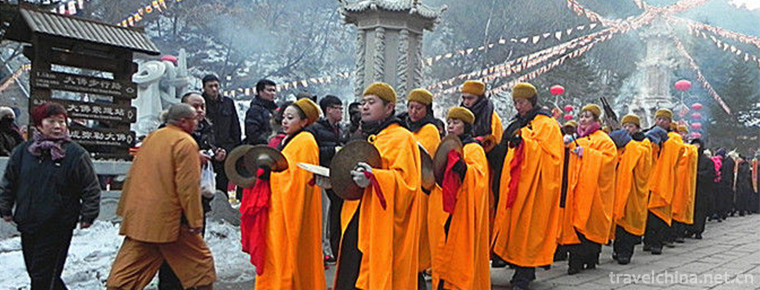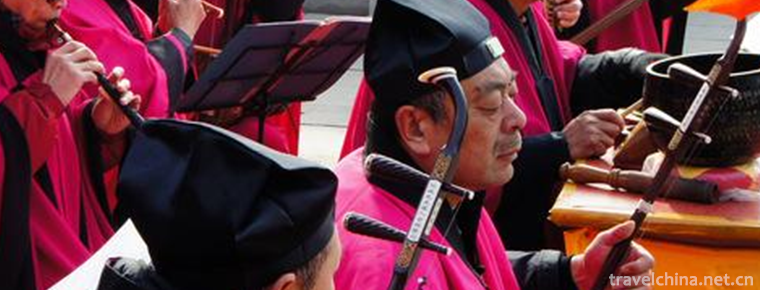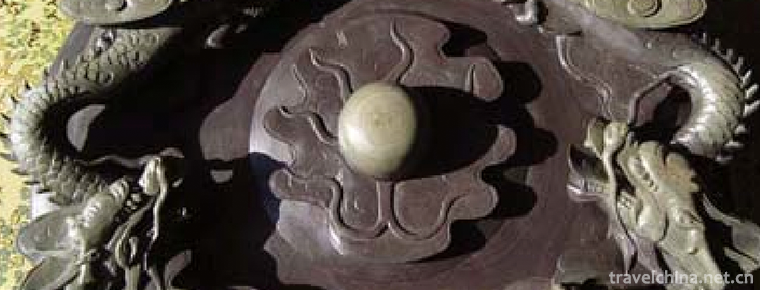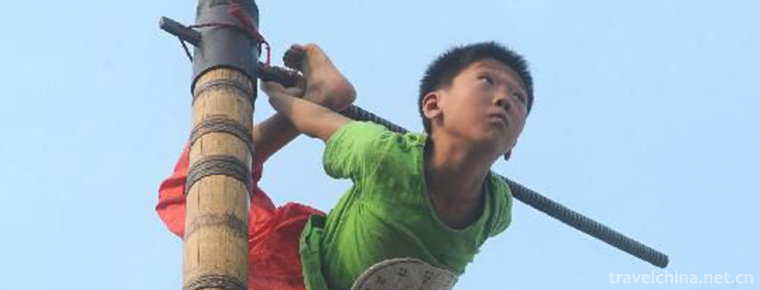Qianshan Temple Music
Qianshan Temple Music
Qianshan, located 20 kilometers southeast of Anshan City, Liaoning Province, is one of the most famous scenic spots in the country. In the northeast, Qianshan is as famous as Changbai Mountain in Jilin Province and is known as the "Pearl of Northeast China". It is said that this mountain is known as Qianshan because of its ups and downs and its nearly 1000 peaks.
Qianshan is a resort of Buddhism and Taoism, while Qianshan temple music is divided into Buddhism music and Taoism music.
Qianshan Buddhist music is gradually formed and developed in various Buddhist activities held in temples. It has continuously absorbed the nutrition of folk music, and absorbed the essence of art from India's music, such as Sanskrit music, to maturity and perfection in the Jin and Ming and Qing Dynasties. Qianshan Buddhist music consists of chanting sutras and instrumental music. The instrumental music is mainly Shengguan music. Its music cards are mostly the same as those of Shengguan music popular in southern Liaoning. The traditional tone of chanting classics belongs to the northern rhyme, which has a long history. At present, its starting age is unknown.
On May 20, 2006, Qianshan Temple Music was approved by the State Council to be included in the first batch of national intangible cultural heritage list.
Historical origin
Buddhism and Taoism coexist in a mountain. This rare phenomenon makes Qianshan full of legendary color. This also makes Qianshan temple music a cultural treasure, because it includes Buddhist music and Taoist music. The two instruments are almost the same, but the content and charm of recitation are different.
History of Buddhist music
Buddhist music is gradually formed and developed in various Buddhist activities held in temples. It has a history of 1300 years so far. According to historical records, since the mid-Tang Dynasty, during Buddhist activities, monks have gathered in Qianshan from Heilongjiang, Jilin, Shandong, Hebei and other places, thus providing quality products for Qianshan Buddhist music. At the same time, Qianshan Buddhist music constantly absorbed the nutrition of traditional folk music, and absorbed the essence of art from religious music such as India's Sanskrit music, and became mature and perfect in the Ming and Qing Dynasties. About the formation of Qianshan Taoist music (Northeast New Rhyme), there are Taoist personages'own opinions. According to reports, more than a hundred years ago, there were two Ban brothers, who were both Beijing opera actors at that time, because they could not aspire to the infinite view of Qianshan (one is a view of Taoism in Yiwulu Mountain). Nowadays, the new rhyme used by Taoists in Northeast China is created by the two brothers of Elucidation. It is said that in the process of wounding the cavity, the two men scored no difference in singing when they were sitting with their backs in the middle of a boulder. It can be seen that his conscience is painful and he has made extraordinary efforts. The two brothers eventually died of exhaustion and illness. Before the advent of New Rhyme, Taoist chanting music in Northeast China was called Laoshan Rhyme. The rhyme was probably introduced from Shandong, and no one can sing it now. After the advent of the new rhyme, Laoshan rhyme was replaced by Laoshan rhyme in Northeast China and became the only rhyme of Taoist chanting, which has been circulating for more than a hundred years. The melody of the new rhyme is smooth, and quite a part of it is beautiful and beautiful. It has a strong religious style, solemn and solemn.
History of Taoist music
Qianshan Taoist music was introduced from Tiesha Mountain to Wuliangguan in the reign of Kangxi. According to legend, more than a hundred years ago, two brothers of the Ban family were opera performers, because they came to Qianshan to see and store their hair in endless depression. They used their lifelong energy to create the "Northeast New Rhyme". The most obvious feature of the two brothers is to closely link up the musical phrases, giving people a sense of integration and inseparability. Legend has it that the two brothers are sitting and singing the new rhyme of Northeast China across huge stones. Eventually they both died of exhaustion due to overwork and illness. Before the advent of "New Rhyme in Northeast China", Laoshan Rhyme, the main Taoist rhyme in Northeast China, was said to have been introduced from Shandong Province. After the emergence of the new rhyme, it soon spread to Taoism in Northeast China. Now the Quanzhen Temple of Taoism in Northeast China adopts "New Rhyme".
artistic characteristics
Buddhist Music
Qianshan Buddhist music is different from other temple music. Its characteristics are clear rhythm, high pitch, bold and rough melody and passionate emotion. It has both strong religious color and distinct local characteristics. Qianshan Buddhist music is divided into vocal music and instrumental music. The vocal music part is divided into two parts: Zen music and coping rhyme. "Zen rhyme" is characterized by percussion accompaniment, while "coping rhyme" is accompanied by Sheng wind instruments, mostly used to play "Yankou". Qianshan Buddhist music is also rich in chanting forms, such as solo singing ("praise head", "start tune"), chorus, direct singing, rhyme and so on. Most of them are tuned by "Vena Master" leading tune, and all monks should join in. "Direct singing" is a unique style of Buddhist songs, there are two types of singing and semi-singing. The melody of "singing type" is stronger than that of "semi-singing type", which is close to rap, and is widely used in "Yankou". Qianshan Taoist music was introduced into Wuliangguan from Liu Zu in Tiesha Mountain during the reign of Kangxi. After being processed by two Taoists from Liyuan family, more than 400 pieces of music such as "Northeast New Rhyme" were created, including six minor rhymes, thirteen major rhymes and hiking horse rhymes. New rhyme can be classified from two aspects: rhyme and part of speech. From the rhyme category: big rhyme, small rhyme, walking horse rhyme, confession, chanting classical tune; from the content of the words: 1) Yang rhyme, also known as verve, such as "Liu Hanyan Yan". (2) Yinyun, also known as ghost rhyme.
The performance of Qianshan Buddhist music is composed of such national percussion instruments and instruments as Sheng, Guan and Flute as drums, cymbals, cymbals, clangs, hafs, bells, gowns, gowns, wooden fishes and bell striking. It is divided into three parts: cymbals, cymbals, chants and instrumental music.
Taoist music
Qianshan Taoist music is played by the combination of wind instruments such as xiao, flute, single (double) pipe, sheng, bell and drum, big gown, leading gown, Dang zi, Hao zi, hitting bell, wooden fish and other percussion instruments.
Representative Works
Around the 1920s, some monks went to Yingkou, Changchun and Harbin to build temples and brought Southern Rhyme to the Northeast. Since then, Southern Rhyme has been widely spread in temples. Over time, fewer and fewer monks can recite traditional Northern Rhyme in Northeast monasteries. Northern rhyme can be divided into two categories: Zan and Sanyun in terms of melody. The part of Sanyun has been basically collected, but the collection of Zan is very few, with an estimate of no less than 80, but at present only about 30 are collected, such as Doubao, Tiantong, Padlock, Wufangjie, etc. Qianshan Buddhist Sheng wind music can only be played by a few Buddhist monks. Most of its repertoires have been lost. So far, only 20 pieces have been retained, such as Lufeng Ming, Tianzun Yun, Sanyi and so on.
Inheritance significance
Qianshan Taoism adopts the new rhyme of northeast China. In addition to Qianshan Taoism, the new rhyme of northeast China is used by all Taoist views of northeast China. Because some of the melodies of "Beiyun" are still in the form of oral transmission by some old artists, many of them have been lost, and now some of them are also on the verge of being lost. At present, there are only dozens of temple opera cards found and collected, which are far from the hundreds known.
In the early 1990s, some old artists once performed in Southeast Asia with Qianshan temple music. Everywhere they went, they were warmly welcomed. He said that the cultural essence of these lost cultures must be protected. At present, the relevant departments have organized manpower to conduct in-depth research on Qianshan temple music, contact the folk artists in the surrounding areas such as Qianshan, dig out relevant words and audio-visual materials, and give certain grants to the artists, encourage them to pass on. Skill. Several folk artists'symposiums and expert demonstrations were held specially. Detailed protection plans were formulated and implemented. Qianshan Temple Music was officially put on the protection agenda.
However, although there are many literary and image materials of Qianshan temple music, with the development of the times, there are also some problems in inheritance and development affected by external and own conditions. Some traditional temple sacrificial activities have gradually become simplified, resulting in a gradual reduction of the main activities of temple music. In the past, more than a dozen music classes played together has been very rare. Without a platform to show, no matter how good the form of music is, it will also be depressed. Moreover, some accomplished temple music performers, some of whom have retired from the front desk because of their seniority, some monks and monks have passed away, playing skills and understanding of music can not be timely inherited, which also has a great impact on the spread of temple music. At the same time, people's cultural life is becoming more and more abundant, their interest in temple music has become weak, and the number of people who are willing to enjoy it is decreasing, and some who can play are not focused on performance. At present, the relevant departments are intensifying their efforts to conduct in-depth research on Qianshan temple music, and formulated detailed protection programs to explore its unique religious and cultural heritage, highlighting its historical and cultural value.


-
Twicecooked pork slices
Twice cooked pork is a traditional dish of Sichuan.
Views: 194 Time 2018-10-12 -
Jinsi Gorge Scenic Area
Jinsi Gorge Scenic Area of Shangluo City, Shaanxi Province, is located in the hinterland of Xinkailing in the southeast of Shangnan County, Shangluo City..
Views: 111 Time 2018-12-12 -
Libo Karst
Maolan National Karst Forest Nature Reserve, located in the southern suburb of Libo County, is a well-preserved natural forest vegetation in the karst landform of the central .
Views: 156 Time 2019-01-29 -
Taoist Music
Taoist music is one of Chinese religious music. Taoist music is an indispensable part of Taoist rituals. It has the characteristics of foiling and rendering religious atmosphere, enhancing believers'y.
Views: 212 Time 2019-04-25 -
Smelting Technology of Gold Chute Stone fill Stove
The smelting technique of gold chute rockfill stove was first seen in the history of Song Dynasty. Since the fourth year of Jingde in the Song Dynasty, Minister Pan.
Views: 252 Time 2019-05-04 -
Inkstone Platform Making Skills
Inkstone production skills, Liaoning Province Benxi City, Ningxia Hui Autonomous Region Yinchuan City, Hebei Province Yi County, Shanxi Province Xinjiang County, Gansu Province Zhuoni County, Min Coun.
Views: 88 Time 2019-07-10 -
Zuo Gezhuang Club
Chongxin Village is located in Zuogezhuang, northeast of Wen'an County. Its economic prosperity and people's prosperity have become the material and cultural basis for the preservation and continuatio.
Views: 377 Time 2019-08-16 -
Beijing Sport Univerrsity
Beijing Sports University was founded in 1953, formerly known as the Central College of Physical Education, renamed Beijing Sports College in 1956 and Beijing Sports University in 1993. It is a nation.
Views: 174 Time 2019-09-06 -
Communication University Of China
Communication University of China ( Communication University of China Referred to as "Zhong Chuan", located in the capital city. Beijing Yes. Ministry of Education of the People's Republic o.
Views: 123 Time 2019-12-03 -
Rongxian Gaoshiti Forest Park
The landform of Gaoshiti Forest Park is peculiar, with boulders, odd peaks, valleys and streams forming a typical natural landscape of low mountain landform in southern Sichuan. Gaoshiti Forest Park covers a total area of 182.13 hectares. It was approved as a provincial forest park by the provincial forestry department in 1993..
Views: 170 Time 2020-10-15 -
Plant resources in Neijiang
Neijiang City is a subtropical evergreen broad-leaved forest belt with mild climate and abundant rainfall, which is suitable for the growth of a variety of trees. There are more than 60 subjects, 110 genera and 190 species. Neijiang is mainly composed of timber forest.
Views: 304 Time 2020-12-16










